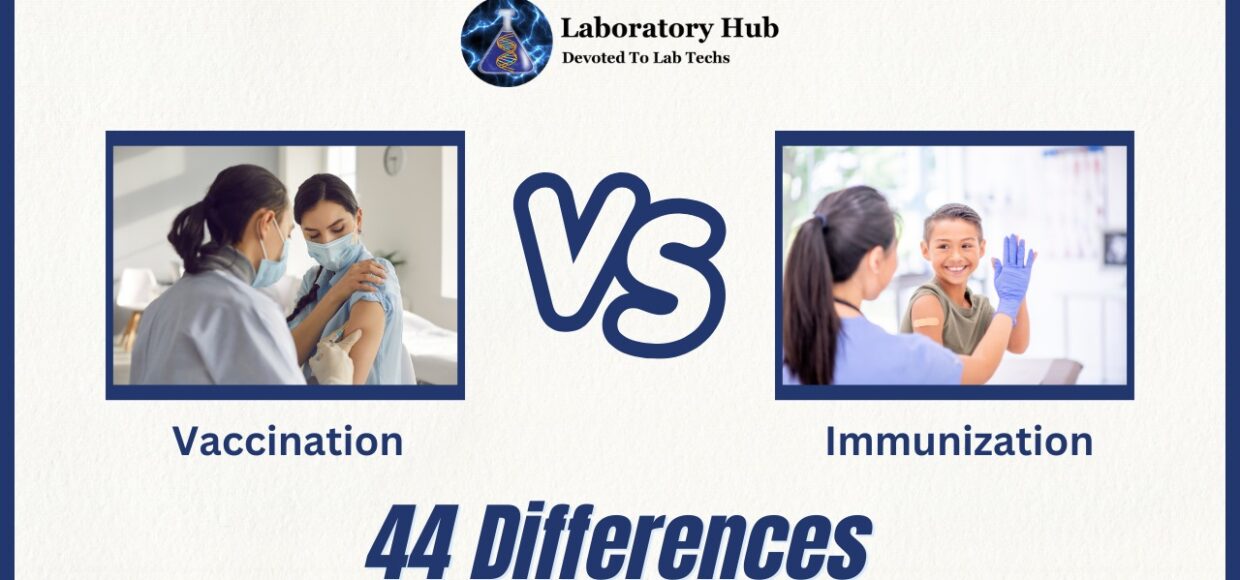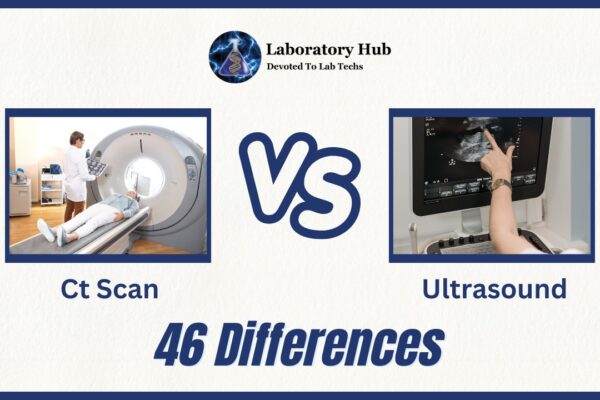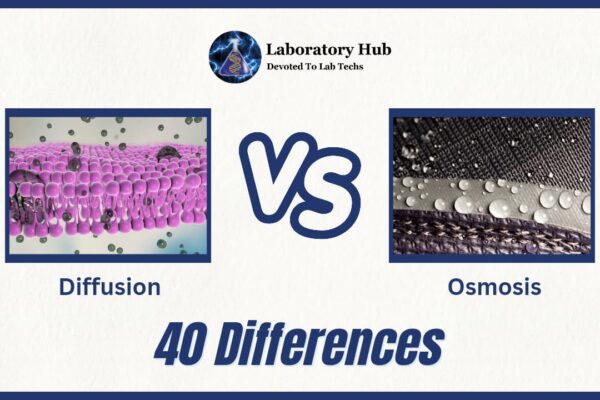44 Difference Between Vaccination and Immunization
Vaccination and immunization are critical components of public health initiatives aimed at limiting infectious disease spread and protecting individuals and populations from dangerous illnesses. They include the introduction of a pathogen (such as a virus or bacterium) into the body in order to trigger an immune response without producing the disease itself. This immune reaction produces antibodies and memory cells, which provide long-term protection against new infections.
VACCINATION
Vaccination is a medical technique in which a vaccine is given to a person in order to activate their immune system and protect them from a specific disease that is transmissible. Vaccines are often generated from pathogens (such as viruses or bacteria) that have been weakened, killed, or changed, or from their components, such as proteins or carbohydrates. These compounds in the vaccination stimulate the immune system without producing the disease.
Vaccination triggers an immunological response that results in the development of antibodies and memory cells. Antibodies are proteins that aid the body in recognizing and combating a specific infection in the event of future exposure. Memory cells “remember” the pathogen and can build a defence quickly if the person is later exposed to the real infectious agent. This procedure confers immunity to the disease and aids in the prevention or treatment of illness.
IMMUNIZATION
Immunization is the method of developing immunity to a certain disease through placing a pathogen (such as a virus or bacteria) into the body in an impaired or inactive state. The goal of vaccination is to increase the immune system’s recognition and memory of the pathogen while avoiding disease, so that if the person is later exposed to the same virus, their immune system can establish a prompt and efficient defence to prevent the disease from occurring.
Immunization entails the administration of vaccines, which are meant to elicit an immune response comparable to that of a natural infection but without producing the sickness itself. When a vaccine is administered to the body, the immune system detects the pathogen elements in the vaccine and generates antibodies and memory cells to combat it.
These memory cells “remember” the pathogen, helping the immune system to respond promptly and efficiently in the future if an individual is exposed to the real disease-causing infection.The ultimate goal of immunization is to generate immunity on an individual and across the population.
Here are 44 differences between vaccination and immunization:
Also Read: Diarrhea vs Dysentery- Definition and 25 Major Differences
S.No. | Aspect | Vaccination | Immunization |
1 | Definition | The act of administering a vaccine to stimulate the immune system | The process of becoming immune to a disease, either through vaccination or natural infection |
2 | Timing | A specific event or action | A gradual process over time |
3 | Purpose | Preventing or mitigating a specific disease | Developing immunity against various diseases |
4 | Agents Used | Vaccines containing weakened or inactivated pathogens or antigens | Pathogens, antigens, or vaccines |
5 | Method | Administering a vaccine through injection or oral ingestion | Achieved through vaccination or natural exposure |
6 | Active or Passive | Active immunization as the immune system responds actively | Passive immunization with pre-formed antibodies |
7 | Duration | Offers protection for a variable duration, often requiring booster shots | Provides long-lasting or lifelong protection |
8 | Targeted Diseases | Targets specific diseases or pathogens | Can provide immunity to multiple diseases |
9 | Natural Exposure | Does not involve natural exposure to the disease | Can involve natural exposure to the disease |
10 | Individual vs. Populational | Focuses on individual protection | Can benefit both individuals and populations |
11 | Preventive Measure | A proactive preventive measure | Can be a result of vaccination or natural infection |
12 | Herd Immunity | Can contribute to herd immunity | Achieves herd immunity when a sufficient portion of the population is immune |
13 | Variability in Response | Variable individual responses | Generally consistent responses in populations |
14 | History | Involves the use of vaccines | Can be achieved through vaccination or natural means |
15 | Boosters | Often requires booster shots to maintain immunity | May not require additional actions to maintain immunity |
16 | Immune Memory | Stimulates immune memory for specific pathogens | May involve memory for multiple pathogens |
17 | Risk of Disease | Reduces the risk of developing the targeted disease | Reduces the risk of developing multiple diseases |
18 | Timing of Protection | Provides protection after vaccination | Protection may develop gradually over time |
19 | Types of Vaccines | Various types, including live attenuated, inactivated, and subunit vaccines | Achieved through natural infection or vaccination |
20 | Control of Outbreaks | Can help control outbreaks and epidemics | Natural infections can lead to outbreaks |
21 | Cost | Incurs costs for vaccine production and administration | No direct cost for natural immunization |
22 | Artificial Immunity | Achieves immunity through artificial means | May result from both artificial and natural means |
23 | Role in Eradication | Can contribute to the eradication of certain diseases | Natural infections may hinder or facilitate eradication efforts |
24 | Immunization Programs | Part of organized immunization programs | Not part of organized programs for natural exposure |
25 | Vaccine Safety | Subject to safety testing and monitoring | Natural infections may have varying degrees of safety |
26 | Timing of Effectiveness | Takes time for immunity to develop | Immediate protection after vaccination |
27 | Allergies | May cause allergic reactions in some individuals | Natural infections can also trigger allergies |
28 | Public Health Efforts | Integral to public health strategies | Natural immunization is not controlled by public health measures |
29 | Storage and Handling | Vaccines require specific storage and handling | No specific storage and handling requirements for natural immunization |
30 | Immunization Coverage | Coverage rates monitored and targeted | No monitoring of natural immunization coverage |
31 | Vaccine Development | Involves research, development, and production of vaccines | Natural immunity results from exposure to pathogens |
32 | Primary Prevention | Primary method for preventing certain diseases | Natural infections may or may not be preventable |
33 | Informed Consent | Requires informed consent for vaccination | Natural immunization occurs without consent |
34 | Vaccine Schedule | Follows specific vaccine schedules | No specific schedule for natural immunization |
35 | Effect on Disease Incidence | Reduces disease incidence in vaccinated populations | Disease incidence can vary widely in populations |
36 | Immune Response Control | Controlled immune response through vaccination | Natural immune response can vary unpredictably |
37 | Lifespan of Immunity | Lifespan of immunity varies by vaccine type | Lifespan of immunity can vary for natural infections |
38 | Contraindications | Specific contraindications for some vaccines | No specific contraindications for natural immunization |
Also Read: Introns vs Exons- 25 Major Differences
Frequently Asked Questions (FAQs)
Vaccination is critical for controlling the spread of infectious diseases and safeguarding individuals and communities from potentially fatal infections. It aids in the control of epidemics and adds to herd immunity, lowering the total disease burden.
Vaccines are subjected to extensive testing in clinical trials before they are approved for use. Following clearance, they are constantly evaluated for safety. While vaccines can cause adverse effects, they are usually minor and transient, such as discomfort at the injection site or a low-grade fever.
Herd immunity (also known as community immunity) arises when a large proportion of a population develops immunity to a disease, either through vaccination or prior infection. This subsequently safeguards individuals who are not immune by limiting the disease’s ability to spread within the community.
Vaccines recommended for children differ by country and location. Common kid immunizations, on the other hand, include those for diseases such as measles, mumps, rubella, polio, diphtheria, tetanus, pertussis (whooping cough), and others.
No, scientific evidence has repeatedly demonstrated that immunizations do not cause autism. The initial study that suggested a link between vaccines and autism has been debunked and withdrawn, and numerous large-scale studies have revealed no such link.







